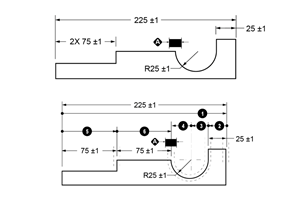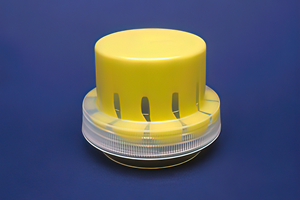Maintenance Data for Processing Technicians
Data that processors need and what they should collect.
Share
In the Navy, many different trades such as hydraulics, electrical, airframes, armament and jet engine mechanics worked side by side to get a plane into the air to fly the scheduled operation, returned to base and turned around to do it all over again. All classes (departments) interacted while doing their own thing to keep a squadron of a dozen A-14 jet fighters “mission ready”—our mantra.
What was done was based on a specific amount of flight time (hours in the air) and environment, that would determine which three levels of PM a jet would receive. Even if it did nothing but sit on the runway, it received some type of periodic inspection just to be sure that nothing was left to chance.
Obviously, getting a jet into the air at a moment’s notice could be considered a higher level priority than getting a mold started and running good parts—depending upon your point of view. The lesson for me was in seeing how standardized data formats allowed critical information to be collected and utilized by all departments. It had to be this way to prevent potential chaos that could occur if every department worked in isolation from other each other through the “that’s not my job” approach.
The ultimate success of manufacturing business is also based on teamwork. One department alone will not take you to the promised land.
Maintenance Is Maintenance
This military maintenance methodology works the same way in plastics manufacturing. Although all departments contribute something to the manufacturing and selling of plastic products, there are a few that deal directly with the everyday applications of molding products. These are the front liners.
This article will discuss what type of mold performance and maintenance information is needed for the front liners and how to use it effectively. The right data, at the right time, in the right hands is the most powerful tool in your box.
In the Beginning
Our analysis will begin at the obvious starting point—a production ready mold (blue or green tagged) set in the press watered up and ready to go.
There are many processing questions a mold start-up technician will ask himself before the first parts come off the mold. Having access to documentation and check lists for start-up direction makes this task much easier.
Many companies provide their process techs with a work order packet that gives some process and production instructions for a particular part number to be run. This information is normally production related—not performance or repair. But once the mold is shot, and problems occur, then more in-depth knowledge of the mold’s characteristics during performance and repair (PAR) will be required to quickly troubleshoot and resolve the problems.
PAR Is Good
PAR type information won’t be found in your typical work order packet. It will be found within the gray matter of a technician's experience with common performance issues of this mold, running this configuration, in this press, with this resin, etc. In other words, whatever can be remembered about this specific setup. In world class shops this data will be electronic and available in several departments.
If the start-up technician does not have quick and easy access to PAR data, then troubleshooting will become a “tweak-and-see” exercise and valuable time will be wasted. In attempting to solve a product issue, technicians will try various process adjustments to get production going, and these workarounds many times hide root causes—such as mold issues—that could be repaired or eliminated when a mold is on the bench, thus making the processes more robust with less fiddling required from start to part.
To acquire this advantage, data continuity must first be established between the toolroom and the processing floor (at the press) to share valuable information that both departments can use to eliminate the guesswork and wasted time and money trying to remember what was done in the past, who did it and what is needed now.
Here is a sample of PAR data that process technicians should be aware of before they start a mold:
• Configuration Changes or Change-overs
- Different tooling installed in a mold base to run a different part number can greatly influence process para-meters and mold characteristics.
• New Tooling Installed
- From a Q/A standpoint, areas of parts formed by new tooling need to be measured and qualified before product can be released. New tooling can also have an effect on the process.
• Cavities Shut Off
- Cavities that the toolroom cannot repair and remain blocked need to be brought to the attention of the processor in case shot size or other adjustments need to be made before the mold is shot.
• Hot Runner Manifold Maintenance
- Not knowing a manifold is empty can cause serious problems. Freshly cleaned/purged hot runner manifolds must be filled slowly to ensure critical seals are not blown open from high pressures.
Mold Disassembly and Clean Level
Maintenance can induce several issues that a process tech might see at start-up and would need to be verified quickly to keep from wasting time looking for processing workarounds when troubleshooting at the press.
Granted, it is not necessary for a start-up tech to know up front every detail about a typical mold PM or clean and repair, but they must have quick access to this data in case issues should arise. And just as repair technicians like to know how many cycles a mold ran before they begin repairing it, a processor likes to know generally what was done to a mold before starting it up, especially if the mold is a problem child.
Any of the issues noted below could be related to maintenance performed or not performed.
It also should be noted that the common theme to troubleshoot ANY issue that occurs is dependent upon one’s ability to answer the first three questions on the Troubleshooting Flow Chart.
Water, oil or air leaks
- Does the mold have a history of leaking and where?
- Was the mold recently worked on and were any o-rings changed or disturbed?
- Did the mold receive a thorough final check before being sent to production? If it didn’t leak on the bench, then it could be clamp or injection pressure related (cracked tooling) and will need to be run or dry cycled to locate the source of the leak (see past articles on this).
Non-fill or shorts
- Were the vents cleaned and when was the last time they were checked for correct depth?
- Is this a reoccurring issue?
Parts Flashing
- Was this specific flash present during the last production run or noticed in the last shot inspection?
- Was any tooling replaced that could affect the stack-up of the tool or the severity, location or direction (horizontal or vertical) of the flash?
Parts sticking
- Has the tooling been polished or in need of re-plating?
- When were the thermal pins last changed?
Dimensional issues
- When was the last time the bubblers (internal water fountains) were cleaned and in what kind of shape are the mold plate water lines?
Mold Damage
- What type of damage is it and did it reoccur in the same area?
Flashed Mold
- Flashed between the A and B or stripper plates; is this easily done with this mold?
Flashed Hot Manifold
- Is there a history of this in this press, or shift, or with an individual?
- With this resin?
- Was the manifold sent out for cleaning recently?
- Are there start-up procedures in place for the tech to follow?
Process Data Responsibilities
Teamwork is enhanced when knowledge is shared about critical aspects of a job that someone in another department relies on to perform their own jobs as efficiently as possible. Not only should processors have log-on privileges in maintenance databases to view specific information, but it only makes sense that they also shoulder some of the data collection responsibilities on the molding floor to ensure that mold performance is accurately represented and the correct issues are noted within the database.
Here is a sample of what setups and processors should be collecting at the press to do their part in the data metric.
Mold Performance Data
• Mold start-up date and time
• Press number
• Mold configuration
• Start-up technician
• Complete defect profile
- Product and mold defects (name them) suffered during the run
- Date and time defects noted or blocked
- Cavity ID or mold position of the defect
- Who noted or wanted the defect blocked (floor personnel, Q/A, etc.)
• Stop dates and times
• Stop (or pull) reason
• Mold status (red or green tagged)
• If a short description is in order that would help the toolroom determine the root cause of an issue, then the document or electronic format should include a place to provide this information.
In-Press Mold Servicing
If molding floor employees are periodically cleaning molds in-press during long production runs—as they should be—these dates should also be documented so repair techs can rule out dry and gummy tooling as potential root causes that precede galling, tool breakage, sticky mechanisms and other problems.
In our country, a major disconnect still exists today between departments—such as tooling and processing—with each concerned primarily about their own specific responsibilities instead of the bigger picture of how to better mold quality parts on time. Some of this disconnect is due to employees feeling overburdened with expanding job descriptions created through lean processes, or simply reduced headcount and budgets. The disconnect is sustained by our reactive, firefighting culture that breeds the “just get it fixed—no time to document” maintenance strategies.
In the U.S. we have the skills and technology but often lack the teamwork to effectively maximize them—while our overseas competition has the teamwork—but struggle with the skills and technology. But these can be bought or brought in—acquiring teamwork is more difficult because it relies on internal discipline, employee commitment and managerial styles. Those that put it all together first wins the business—thus the race.
PAR information is not only a powerful tool to have in your arsenal, but vital to one’s long-term success and profitability. All employees share a responsibility to accurately document critical areas of their jobs so that their teammates can be aware of certain specifics that directly relate to their own jobs.
Summary
Take a look at the big picture and then make the changes necessary to achieve the common goal—before the competition. Technology and skill alone will only carry you so far upstream—everyone needs to row together.
Related Content
What Is Scientific Maintenance? Part 1
Part one of this three-part series explains how to create a scientific maintenance plan based on a toolroom’s current data collection and usage.
Read MoreTolerancing in Mold Design, Part 1: Understanding the Issues of Conventional Bilateral Tolerancing
Mold designers must understand the location, orientation and form limitations of conventional tolerancing before changing to another dimensioning system.
Read MoreHow a Small Programming Change Cuts Cycle Time in Half
Overriding the CAM system when milling a series of lifter pockets helps to improve metal removal rate and increase feed rates.
Read MoreHow to Manage Wall Thickness Changes in Your Mold Design
To ensure even filling and cooling, consider wall section transitions, corners and fillets, ribs and bosses, lip and rim designs and CAE flow simulation software.
Read More















